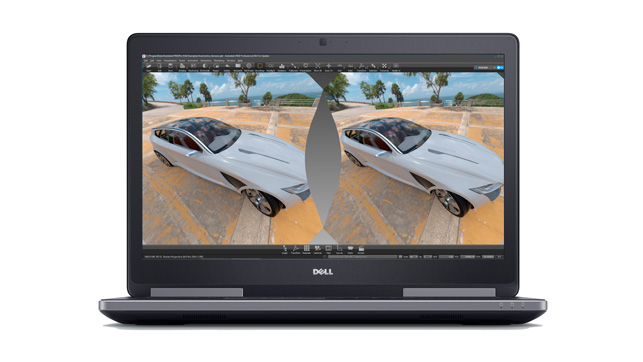Dell Precision 7720 – With powerful processors, impressive cooling, good serviceability and excellent build quality, this 17-inch mobile workstation is hard to beat if you want to take CAD, viz and VR on the road
Dell’s 17-inch Precision mobile workstation has come a long way since the early 2000s when Dell simply put workstation parts inside a budget consumer Inspiron chassis.

The latest model, the Dell Precision 7720, is all about premium materials and build quality. With a machined magnesium alloy chassis, carbon fibre lid and soft touch palm rest it is both exceptionally strong and stylish.
Serviceability was all the rage a few years ago, but many vendors have now prioritised slender form factors over the ease with which key components can be replaced.
At 28.5mm (front) and 34.49mm (rear) the Dell Precision 7720 may be slightly thicker than the HP ZBook 17 and Lenovo ThinkPad P71, but all internal components have easy access. Notably, the battery and 2.5-inch HDD can be got at very quickly thanks to a tool free service panel.
Then, if you want to access the memory or the two M.2 NVMe SSDs simply remove two screws and slide off a second panel. Weighing in at 3.42kg, this is not a light machine, but pretty average for a 17-inch mobile workstation. The 240 Watt AC adapter is slim, but adds an additional 1kg, including UK plug.
Like most 17-inch mobile workstations, the Precision 7720 is all about performance. Our test machine came fully loaded with the kind of spec you’d expect to find in a mid-range desktop workstation. This includes a quad core Intel Xeon E3-1535M v6 CPU (3.10GHz to 4.20GHz Turbo) and Nvidia Quadro P5000 GPU (16GB GDDR5 memory). Both are top-end models, but there are plenty of other options should you wish to reduce the £5,129 + VAT price tag. The GPU, for example, goes all the way down to an AMD Radeon Pro WX 4130 if you simply want a large 17-inch screen for precise 3D CAD work.
Dell Precision 7720 – product specifications
■ Intel Xeon E3-1535M v6 (3.1GHz, 4.2GHz Turbo) (4 cores, 8 threads)
■ 64GB (4 x 16GB) DDR4 2,400MHz
■ Nvidia Quadro P5000 (16GB) (385.69 driver)
■ 512GB M.2 NVMe SSD Class 50
■ 17.3-inch UltraSharp PremierColor UHD IGZO (3,840 x 2,160) AntiGlare
■ 417 x 281 x 29-34mm 3.42kg
■ Windows 10 Pro for Workstation (up to 4 core
■ 3Yr ProSupport and Next Business Day on-site
CPU benchmarks (single threaded) Seconds (smaller is better)
SolidWorks 2015 IGES export (single threaded): 103
CPU benchmarks (single threaded) Seconds (smaller is better)
Luxion KeyShot 6.1 render test (multi threaded): 762
V-Ray render benchmark (CPU) (multi threaded): 167
GPU compute benchmark Seconds (smaller is better)
V-Ray render benchmark (GPU): 101
3D graphics benchmarks (3D CAD) Score (bigger is better)
SPECapc for SolidWorks 2015 (shaded + edges): 4.39 (test run at 4K)
SPECapc for SolidWorks 2015 (RealView + shadows): 7.87 (test run at 4K)
SPECapc for SolidWorks (RealView + shadows + AO):18.26 (test run at 4K)
SPECapc for PTC Creo 3.0 (shaded + edges): 8.81 (test run at 4K)
SPECapc for PTC Creo 3.0 (reflection): 13.3 (test run at 4K)
3D graphics benchmarks (design viz) Frames Per Second (FPS) (bigger is better)
LumenRT (hotel model) (FPS): 23 (test run at 4K)
LumenRT (roundabout model): 12 (test run at 4K)
Autodesk LIVE (Villa Enhanced model): 44 (test run at 4K)
Autodesk VRED Professional (AA off): 28 (test run at 4K)
Autodesk VRED Professional (AA medium): 16 (test run at 4K)
Autodesk VRED Professional (AA ultra high ):6 (test run at 4K)
3D graphics benchmarks (VR) Frames Per Second (FPS) (bigger is better)
VR Mark (Orange): 168.87 (VR resolution
VR Mark (Blue): 32.83 (VR resolution
VR Mark (Cyan): 98.03 (VR resolution)







